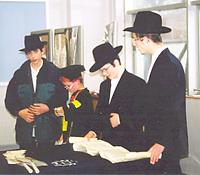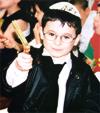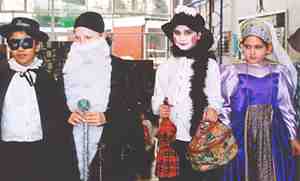
 Judaism Judaism
 Purim
Purim
Introduction to Purim
Purim is one of the
most entertaining Jewish holidays.
In 2001 Purim falls on 9
March.
Purim commemorates the time when the Jewish people
living in Persia were saved from extermination by the courage of a
young Jewish woman called Esther.
Carnival Time
It
is customary to hold carnival-like celebrations on Purim, to perform
plays and parodies, and to hold beauty contests.
Americans
sometimes refer to Purim as the Jewish Mardi Gras.
Purim is
not subject to the restrictions on work that affect some other
holidays; however, some sources indicate that Jews should not go
about their ordinary business at Purim out of respect for the
festival.
Reading the Book
The main commandment
related to Purim is to hear the reading of the Book of
Esther.
 Reading
the Megillah at a school Purim
service Reading
the Megillah at a school Purim
service
The Book of Esther is known
as the Megillah, which means scroll.
Although there are five books of Jewish scripture that can be
called megillahs - Esther, Ruth, Ecclesiastes, Song of Songs, and
Lamentations - The Book of Esther is the one people usually mean
when they speak of the Megillah.
It is read both on the eve of Purim and also on Purim itself. If
Purim falls on the Sabbath, the Megillah is read on the Thursday
evening and Friday morning before Purim.
Synagogue
Celebrations
At Purim Jews read the story of Esther in the
synagogue. It's usually an enteraining and rowdy
occasion...
The synagogue is crowded with men, women, and
children. Some wear their best Sabbath clothes, but many dress up in
colourful costumes and masks.
Making a Noise
The
Purim story has a dreadfully villainous villain called Haman,
and everyone in the synagogue boos, hisses, stamps their feet and
uses noisemakers (called graggers) and cymbals whenever the name of
Haman is mentioned during the service.
| |
 |
|
 |
|
| |
Waving graggers to blot out Haman's
name |
|
The purpose
of this custom is to blot out the name of Haman. Originally, when
Haman’s name was read, the congregation would shout ‘Cursed be
Haman’ or ‘May the name of the wicked rot!’ But nowadays any noise
will do.
Dressing Up
Children in particular enjoy
dressing up as the characters found in the Book of Esther, including
King Xerxes, Vashti, Queen Esther, Mordecai and Haman.
| |
|
 |
|
|
| |
Dressing up for Purim. Mordecai, Esther, and
friends. |
|

The BBC is not responsible for the content of external web
sites.
|